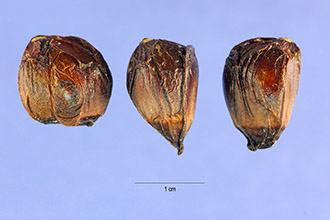Coontie
Scientific Name: Zamia pumila L.

| General Information | |
|---|---|
| Usda Symbol | ZAPU |
| Group | Gymnosperm |
| Life Cycle | Perennial |
| Growth Habits | Subshrub |
| Native Locations | ZAPU |
Plant Guide
Alternate Names
Seminole bread, Florida arrowroot, sago cycas, comptie, contis, comfortroot, wild sago, white-root, white bread-plant
Uses
Ethnobotanic: The Seminole, Alabama, and many other Native American tribes in the southeastern United States used the fruits and roots of coontie for food. Some people still prepare it today. The starchy stems and roots were the main source of flour for the Seminoles and many indigenous people of central and southern Florida. These peoples are attributed with increasing the plant’s distribution. The plant parts contain central nervous system toxins, which must be removed before consumption. To make flour, the roots are first chopped into pieces. They are then pounded with a mortar and pestle. The pulp is then washed with water and the starch is allowed to settle to the bottom. Then the water is drained and the remaining paste is left to ferment for several days. At the end of the fermentation process, the starch is set in the sun to dry. When dry, the powdery, cornmeal-like flour is then baked into bread. Wildlife: Coontie cones reportedly provide food in exchange for pollination services for two species of beetles in Florida, Pharaxonotha zamiae and Rhopalotria slossoni. The seeds are a source of food for mockingbirds, blue jays, and many other birds as well as insects and small mammals. Butterfly larvae feed on the leaflets.
Status
@ PLANTS Please consult the PLANTS Web site and your State Department of Natural Resources for this plant’s current status (e.g. threatened or endangered species, state noxious status, and wetland indicator values).
Description
General: Cycad Family (Zamiaceae). Zamia is one of only a few primitive or ‘relict’ genera, commonly called cycads that are living remnants of plants that were abundant about 325 million years ago. Zamia pumila is the only species of this genus that grows in the United States. Coontie is a fern-like evergreen, perennial shrub (.5 to 1 m in height) with a thick (10 cm in diameter), sometimes branched, trunk that is either very short (to 15 cm) or submerged. The trunk is starchy, which is the reason for the name “Seminole bread”. Dark green fronds grow from the top of the trunk and have 2 to 13 pairs of stiff, leathery leaflets that are 4-9 dm long. Leaf-widths vary among plants. Fronds are from 40 to 80 cm long. Green to dark reddish brown cones grow atop stalks, from the center of the top of the trunk. Male plants bear slender, cylindrical cones that are about 10 cm long and 2-3 cm in diameter. The cone-like reproductive structures on female plants, called “megasporophytes,” are 12 to 13 cm long, 5 cm in diameter. Cones appear in mid-to late summer. The red to red-orange seeds are 1cm to 2 cm long. Distribution: Z. pumilia is endemic to central and southern Florida. Zamia pumila is now rare, not only because of its very small geographic range, but also because people dig up plants in the wild to plant in their gardens. For current distribution, please consult the Plant Profile page for this species on the PLANTS Web site.
Adaptation
These plants grow in dry, sandy pinelands and hammocks, Although salt tolerant, they rarely occur in sandy coastal dunes, Use soil moisture sensors to measure the soil moisture of Coontie.,
Establishment
The plants will grow from seed, but one must be patient as the seeds may take several months to several years to germinate. Plants may be propagated by division. Coonties can grow in full sun to deep shade, but require warm weather. They are drought-tolerant and like well-drained soils. The plants are salt-tolerant and are therefore excellent for coastal landscapes. They make lovely additions to the garden as shrubs or ground covers. Coonties make beautiful specimen plants and grow well in containers, either indoors or outdoors. Cultivars, Improved, and Selected Materials (and area of origin) These plant materials are readily available from commercial sources. Because this plant is threatened by harvesting, be sure to inquire whether the plants were propagated from seed and not taken from the wild. Contact your local Natural Resources Conservation Service (formerly Soil
Conservation
Service) office for more information. Look in the phone book under ”United States Government.” The Natural Resources Conservation Service will be listed under the subheading “Department of Agriculture.”
